Fiber fits the bill as enterprises connect more devices
Passive optical networks, or PON, use fiber optic cables to connect an optical line terminal to dozens of endpoints. The optical line terminal converts electrical signals into optical signals, and splitters are used to distribute those signals to the endpoints. Because the splitters do not require any power, the network is called a passive network.
As fiber replaces copper cable in more buildings, passive optical networks are setting the stage for the internet of the things. Systems that use one signal source to connect many devices are ideal for IoT use cases.
“Passive optical LAN is perfect for internet of things because it has so much data capability and it distributes right out into the endpoints,” said Bobby McClung CEO of integrator AWS Communications. AWS specializes in fiber installations for in-building networks and McClung likes to call himself a “PON evangelist.” He’s talked a number of architects and builders out of traditional copper cable networks and into fiber.
McClung said that passive optical networks use the same technology and principles that Verizon and other service providers have employed to bring fiber to the home. FTTH may become a cornerstone of smart home solutions, because if households try to connect dozens of devices and appliances they may need more bandwidth than cable or wireless can provide.
In enterprise settings, fiber has the potential to support multiple connections with varying bandwidth needs. Fiber that can deliver 10 gigabits per second is expected to hit the market this year, and PON can split the signal from one strand of fiber up to 32 times. This makes PON a natural fit for hospitals, hotels, factories, and other enterprises that may want to connect a variety of equipment to the internet.
When a large number of endpoints need to be connected, network costs will be lower with fiber than with standard Ethernet cable. Installation costs are lower because one strand of fiber can replace hundreds of copper cables. Energy bills plummet because there is no need to power, heat or cool any equipment between the signal source and the endpoint. According to Nokia, in a new installation with 2,000 connections across 10 floors, choosing PON over Ethernet will cut capital expenditures by 56% and operating expenses by 54%.
For more on fiber in carrier networks, download the RCR Wireless FTTx feature report and webinar.

